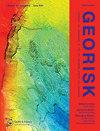Influence of the 2020 Seismic Hazard Update on Residential Losses in Greater Montreal, Canada
IF 4.8
3区 工程技术
Q1 ENGINEERING, GEOLOGICAL
Georisk-Assessment and Management of Risk for Engineered Systems and Geohazards
Pub Date : 2023-10-22
DOI:10.3390/geohazards4040023
引用次数: 0
Abstract
Greater Montreal is situated in a region with moderate seismic activity and rests on soft ground deposits from the ancient Champlain Sea, as well as more recent alluvial deposits from the Saint Lawrence River. These deposits have the potential to amplify seismic waves, as demonstrated by past strong, and recent weak, earthquakes. Studies based on the 2015 National Seismic Hazard Model (SHM5) had estimated losses to residential buildings at 2% of their value for an event with a return period of 2475 years. In 2020, the seismic hazard model was updated (SHM6), resulting in more severe hazards for eastern Canada. This paper aims to quantify the impact of these changes on losses to residential buildings in Greater Montreal. Our exposure database includes population and buildings at the scale of dissemination areas (500–1000 inhabitants). Buildings are classified by occupancy and construction type and grouped into three building code levels based on year of construction. The value of buildings is obtained from property-valuation rolls and the content value is derived from insurance data. Damage and losses are calculated using Hazus software developed for FEMA. Losses are shown to be 53% higher than the SHM5 estimates.2020年地震灾害更新对加拿大大蒙特利尔居民损失的影响
大蒙特利尔位于一个地震活动温和的地区,坐落在古尚普兰海的软地面沉积物上,以及最近来自圣劳伦斯河的冲积沉积物上。这些沉积物有可能放大地震波,正如过去的强震和最近的弱震所证明的那样。基于2015年国家地震灾害模型(SHM5)的研究估计,对于一个周期为2475年的事件,住宅建筑的损失为其价值的2%。2020年,地震灾害模型更新(SHM6),导致加拿大东部的灾害更加严重。本文旨在量化这些变化对大蒙特利尔住宅建筑损失的影响。我们的暴露数据库包括传播区规模(500-1000居民)的人口和建筑物。建筑物按占用和建筑类型分类,并根据建造年份分为三个建筑规范级别。建筑物的价值来源于财产估价卷,内容价值来源于保险数据。使用为FEMA开发的Hazus软件计算损害和损失。损失显示比SHM5的估计高出53%。
本文章由计算机程序翻译,如有差异,请以英文原文为准。
求助全文
约1分钟内获得全文
求助全文
来源期刊
CiteScore
8.70
自引率
10.40%
发文量
31
期刊介绍:
Georisk covers many diversified but interlinked areas of active research and practice, such as geohazards (earthquakes, landslides, avalanches, rockfalls, tsunamis, etc.), safety of engineered systems (dams, buildings, offshore structures, lifelines, etc.), environmental risk, seismic risk, reliability-based design and code calibration, geostatistics, decision analyses, structural reliability, maintenance and life cycle performance, risk and vulnerability, hazard mapping, loss assessment (economic, social, environmental, etc.), GIS databases, remote sensing, and many other related disciplines. The underlying theme is that uncertainties associated with geomaterials (soils, rocks), geologic processes, and possible subsequent treatments, are usually large and complex and these uncertainties play an indispensable role in the risk assessment and management of engineered and natural systems. Significant theoretical and practical challenges remain on quantifying these uncertainties and developing defensible risk management methodologies that are acceptable to decision makers and stakeholders. Many opportunities to leverage on the rapid advancement in Bayesian analysis, machine learning, artificial intelligence, and other data-driven methods also exist, which can greatly enhance our decision-making abilities. The basic goal of this international peer-reviewed journal is to provide a multi-disciplinary scientific forum for cross fertilization of ideas between interested parties working on various aspects of georisk to advance the state-of-the-art and the state-of-the-practice.

 求助内容:
求助内容: 应助结果提醒方式:
应助结果提醒方式:


